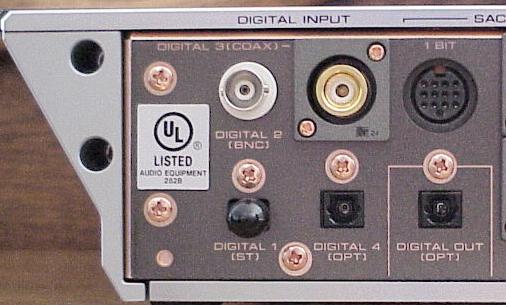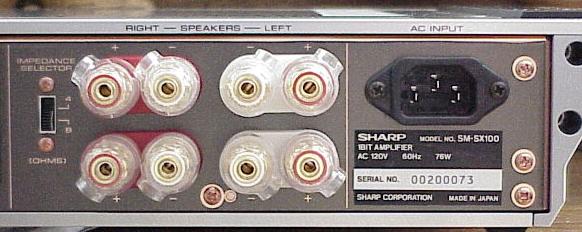Product Review - Sharp SM-SX100
1-Bit Totally Digital Integrated Amplifier - January, 2002
John E. Johnson, Jr.
![]()
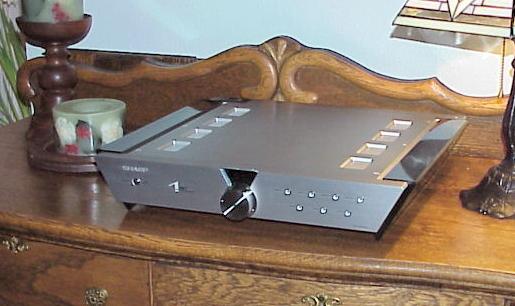 |
Specifications: Format: 64 x 44.1 kHz Switching Power Output: 100 Watts RMS per Channel into 8 Ohms MFR: 5 Hz - 100 kHz ± 3 dB THD: 0.02% at 1 kHz, 1 Watt Size: 5" H x 17" W x 12" D Weight: 41 Pounds MSRP: $15,900 USA |
Introduction
Digital amplifiers have been around for years, but they are not totally digital. Mostly they are hybrid designs, with the "digital" meaning that it uses a digital switching power supply or output stage (Class D Amplifiers).
Recently, Sharp Electronics, known mostly for mass market products, released their digital amplifiers that are digital from input to output. The Sharp SM-SX100 is a 100 watt per channel, stereo digital power amplifier. There are no analog circuits as part of the signal path. If you connect the digital output of your CD player to the Sharp, from disc to speakers, it is a digital signal. Incoming 16/44.1 digital signals are resampled to the Sharp 1-bit rate of 2.8224 MHz. These are 1-bit samples, so to compare the rate to 16/44.1, you have to multiply 16 x 44.1 kHz, which equals 0.7056 MHz. If comparing to DVD-A at 24/96, it is 2.304 MHz, so the difference between the Sharp bit rate (which, by the way, is the same as DSD - SACD) is insignificant. What is different is the nature of the sampling. DVD-A is PCM (Pulse Code Modulation), just like our conventional 16/44.1 CDs. The Sharp and SACD is 1 bit at a time. It is not PCM. So, even though the rate is similar between DVD-A and SACD, the latter technology does not require analog filters, which can result in (theoretically) better sound (these analog filters are an item in the signal path, and any analog structure in the signal path results in at least a small loss, no matter how you design it). Practically speaking, the jury is still out on whether one is "better" than the other (DVD-A vs. SACD), but that is not the subject of this review.
Notes by Colin Miller: You don't need analog filters with DVD-A either at 24/96, 24/192, or 16/44.1, if you don't mind a bunch of ultrasonic noise going downstream. Single bit D/A conversion has the same issue, except that the quantization noise inherent to the front end is FAR higher in amplitude, but also at a higher frequency. Both PCM and DSD use dither on the front end, and any time the bit depth changes, i.e., 24 to 22, 4 to 1, etc., you randomize the quantization error, and turn it into noise. The spectrum of the noise added will depend on the nature of the dither applied. The dither, must, though, be about 1/2 the LSB. With 24 bit A/D converters, the amount of dither can be very small. With 1 bit, or even 4 bit conversion, the dither must be just 6 dB lower than the LSB. With a single-bit system, whether that data stream is generated through conversion from PCM, or what not, the associated noise will be -6 dB from full scale.
What DSD allows you to do is have a
higher sampling frequency at the same data rate, so that you can focus that
noise above the range you actually want, precisely so that you can filter out
that noise. Note, though, that if you want to have any kind of dynamic range,
the bandwidth limits will be far below the Nyquist limit. One can yield the
same benefit of moving the quantization noise above the interested range with
PCM through "over-sampling." DACs that take information at 44.1, and have
common 8x oversampling (built into the DAC) multiply the sampling rate to
352.8 kHz. With 48 kHz, the rate would be at 384 kHz. You could say that after
applying digital filters, the effective data rate would be equivalent to DSD
at 9.2 MHz, but that would be somewhat misleading. Both formats SHOULD
be filtered by an analog circuit, but neither HAVE to be.
So how does this relate to any superiority between the formats?
In terms of linearity, PCM's greatest limiting factor is the tolerances of the
resistors that determine the amplitude of the DAC output, as it is important
that each bit be a certain proportion to the rest of the bits, so that each
bit's extra output is exactly half that of the next more significant bit, and
twice that of the next less significant bit. This becomes very difficult, and
requires laser-trimmed resistors, but manufacturing technology is improving
the cost-effectiveness of high-quality multi-bit DACs. However, many DACs
avoid this problem by
converting the data stream to that of single bits, for reasons below.
Single-bit technology does not have any linearity problems in terms of
matching bit amplitudes, because there is only one bit, and it matches itself
perfectly. However, since the amplitude is more a function of time, the
linearity is more heavily dependent upon the clock accuracy.
Both formats can be highly linear, though, if done well. In terms of
resolution, it's not an easy comparison, because the resolution is inversely
related to the noise floor, and the noise floor is a product of the spectrum
of dither applied, and the filtering applied afterwards. As interesting as it
is to look at the technology involved, if you really want to compare apples to
apples, compare the analog outputs of two otherwise identical players with
similar quality of manufacturing and design. Finding and identifying those
units in itself would be a task.
However, that might be pointless, since both formats have more dynamic range
than the analog electronics can yield, and greater bandwidth than any humans
can make use of. I would argue that the greater benefits are measured in terms
of implementation. PCM is far easier to apply DSP to. DSD is easier to
build converters for, as the data stream can be fed
directly through a filter, or if you don't mind a whole heap of noise,
directly to whatever input you've got.
1-bit isn't "Delta-Sigma" (which is an encoding strategy) - 1-bit in this case is Pulse Density Modulation (PDM). The samples are represented with a frequency modulated square wave, with pulses of equal duration. This is as compared to Pulse Width Modulation, where the duration of the pulses is modulated rather than the frequency of the pulses. One could say that PDM is a frequency domain approach, while PWM is a time domain approach.
Analog sources coming into the SX100 are sampled at 2.8224 MHz as well, and there are a few sources (made by Sharp) that output 2.8224 MHz digital bitstreams, such as from their SACD player. In fact, the Sharp components are the rare set of products right now that have digital outputs from SACD players. More will follow I am sure.
Here is a technical explanation of Sharp's 1-bit engineering, written by John Kotches:
Amplifier Technology Jeopardy , or
What is Sharp's 1-Bit Amplifier Technology?
Our audio systems will quietly be undergoing revolutions. Unlike the digital
revolution (CDs) that began roughly 18 years ago, the new digital revolution is not
for our sources (players) and media (discs). It's for our next to the last chain of the audio
reproduction system, the amplifier. Various strategies of digital
amplification are in place, and Pulse Width Modulation is the most prevalent.
By now, you know already that Direct Stream Digital (DSD, which is the basis
of Sony's SACD) is delivered to consumers
as a 1-bit signal, that is Delta-Sigma encoded into a Pulse Density Modulation data-stream. The essence of this technology is that it represents a raising (+
full on voltage) as a digital 1 and an unchanged, or lowered voltage as a 0 (-
full on voltage). Proponents of DSD technology feel that encoding the
summation of changes is more in tune with our perceptions of sound quality
than the actual voltages. It just so happens that this one-bit DSD data-stream
is ideally suited for driving a digital amplifier. So let's talk about how
this works.
One Bit In, One Bit Out
The master clock of Sharp's 1-bit amplifier runs at a very high 11.2896 MHz -
which is 4 times the clock speed of DSD (2.8224 MHz). This allows for very
precise timing of the amplifier pulses.
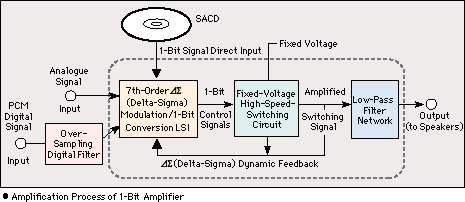
(Diagram Copyright Sharp Electronics,
Inc.)
Sharp's proprietary one-bit input physically resembles an 12-pin DIN connector
(see photo below),
and the DSD data-stream is used to directly drive the amplifier output stage.
Very cool, eh? It gets better. In the recording end, the full on + value is
approximately 2v, and the full on - value is approximately -2v. This is great
if you only want to have one volume setting for your amplifier (you probably
don't!). By adjusting the response of the amplifier so that the cycled voltage
value is a function of the volume control, you adjust the output current and
voltage of the amplifier. The larger the current, the higher the output in
terms of power. Just as with the analog output of an SACD player, the analog
waveform is recovered after amplification with a noise-shaping
low-pass/smoothing filter. In essence, you've extended the DSD bitstream all
the way through the amplification subsystem.
Perfect Sound Forever?
This is great, but you're tied to Sharp's one-bit transport and SACD material
with the 1-bit input. Given limited availability of SACD titles, what about
getting a Redbook CD output into the 1-bit amplifier? No problemo! In a
process quite similar to recording studios, a PCM input can be "sample rate
converted", in a manner of speaking, to have the 2.8224 MHz bitstream which is
then fed to the PDM amplifier directly. This is referred to as 64 times oversampling, but the actual data density is only 4x that of regular CD, due
to the higher resolution of the Redbook CD's PCM encoding. The sample rate
conversion could be accomplished by implementing a simple 4x oversampling
Delta-Sigma encoder to the Redbook CD input. Remember also that even though
the sampling frequency of SACD is higher than a conventional CD, the
information per sample (only 1 bit) is lower, so this is a tradeoff.
Is the input limited? Certainly. As of this writing, sampling depth is limited
to 16 bits, and the sampling frequency is limited to 32 / 44.1 and 48kHz.
Other rates such as 32
kHz and 48kHz would have to be PCM sample rate converted to 44.1 kHz prior to
being fed to the - encoder.
Analog This Baby!
Well this is nice, as we can handle the vast majority of digital outputs
available, but what of analog? A good digital amplifier should be fairly
agnostic, signal wise, and the Sharp amplifiers step up to the task here as
well.
How so? Very simple, my friends? All you need is a DSD Analog/Digital
Converter to sample the analog input into DSD and feed it directly to the
amplifier stage.
That's it.
So this is Sharp's entry into Digital amplifier technology in a nutshell.
- John Kotches -
The chassis of the SX100 is built like the proverbial tank. It is shielded by a copper Faraday cage that can be seen through various openings in the chassis cover such as shown below in the close-up photo of a 1/2" hole (vent) in the chassis bottom.
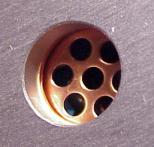
The Faraday cage shields all the sensitive electronics from electromagnetic interference originating outside the chassis.
The front panel is dominated by a large metal lathed volume control. A blue LED readout gives relative volume levels. On the right are push buttons to select among several inputs. This brings up the one complaint I have about the SX100. The default input is always the same, regardless of whatever other input you are using when you turn the unit on. So, unless you are using the default, you have to push the appropriate input button every time you power up. I suspect this will be addressed in future products. In fact, I think the SX100 and its lower powered sisters are really technology prototypes of what Sharp envisions as the future of all consumer electronics, even the mass market products.
The rear panel is loaded with connectors (photos below). From the left are Digital Inputs, including BNC, coax, and Sharp's proprietary input for direct connections to SACD digital output from their SACD players, and two optical inputs. There is no XLR digital input, and I would like to see one in future models. Optical digital out passes signals through. This is followed by (middle photo) RCA analog input jacks, XLR analog inputs, and RCA analog outputs. Speaker terminals - four sets of five-way binding posts (great for bi-wiring) - are gold plated all the way through. The bottom two photos show these posts. I guess they are clear so you can see the gold inside the posts. In any case, they are the most interesting looking speaker posts I have ever seen.
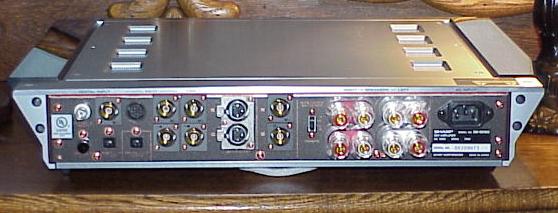
|
Left End |
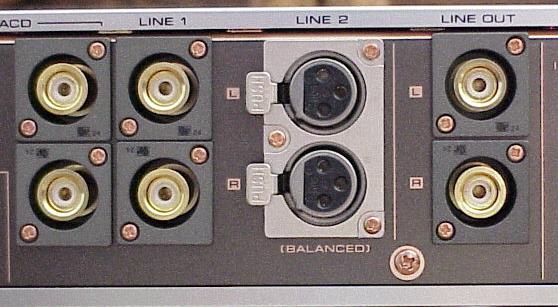 Middle |
|
Right End |
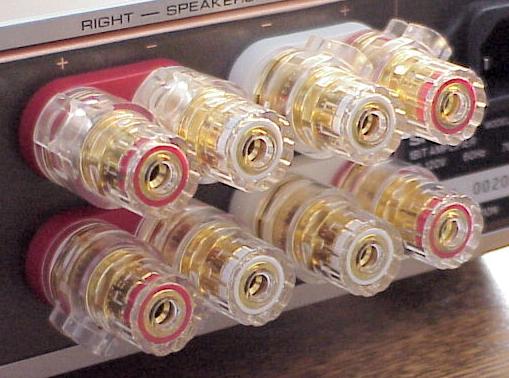
There is a 4 Ohm/8 Ohm speaker selection switch, much like you find on mass market products (!!) The grounded AC socket allows using an after-market power cord if you like. The chassis sits on pointed plastic feet, but the product comes with metal discs to protect cabinet shelf surfaces.
Performance
A number of people listened to this amplifier, including myself, my wife, Jason Serinus, and some professional speaker manufacturers. The opinion was universal. The SX100 is an awesome-sounding product. It does not have a "solid-state" sound or a "tube" sound. It is the most neutral sound I have yet heard from an audio product. That does not mean I prefer it over everything else, but just that it does not have a defining characteristic.
For the tests, I used an Audio Alchemy transport, Magnepan speakers, and Nordost cables.
We listened to everything we could get our hands on . . . classical, popular, movie sound tracks. I could not find anything that challenged the SX100 beyond its capacity. And that was with Magnepans, which are not the easiest loads to drive. The soundstage of Rachmaninoff was impeccable (Rachmaninoff for Romance - Philips 446-851-2). The voicing of Barbra Streisand (Barbra Streisand - Higher Ground - Columbia - CK66181) and Celine Dion (Celine Dion - Collector's Series - Volume 1 - Sony Music) was articulate, yet delicate. Andrea Bocelli's "Verdi" soared (Andrea Bocelli - Verdi - UMG - 289-464-600-2). Sarah Brightman's (Sarah Brightman - La Luna - Angel Records - 7243-5-56968-2-3) soprano pierced the clouds. All the while, center soundstage was maintained perfectly.
The new CD of "Lord of the Rings" is a scary piece of music. If the rosin of the strings is not heard though, some of the impact is lost. The hair on my arms and neck was appropriately raised with the Sharp.
In the classical orchestra arena, symphonies were full bodied and detailed. Piano stood clearly with orchestra in concertos, such as Mozart's "Piano Concerto in B flat" (Philips - 400-018-2). Chamber music spread the full stage between speakers, with each instrument delineated in its proper position (Palladian Ensemble - Trios for 4 - Linn - HON-CD-5050).
Hour after hour of listening never resulted in fatigue. This is not an easy feat in digital audio. And if it sounded this good with the digital output of our conventional CD player, I can imagine what it would sound like with the Sharp SACD player's digital out (John Kotches is testing that player right now).
Conclusion
I have to admit that I went into this review not thinking that the Sharp SM-SX100 would sound like $16,000 worth of audio. Well, it does, and everyone else who heard it agrees with me. And, when you take into account that a high-performance DAC, preamp, and power amp, along with all the interconnects, could easily cost more than $16,000, and not sound as good because of a mismatch somewhere, the Sharp becomes a must-audition.
- John E. Johnson, Jr. -
![]()
© Copyright 2002 Secrets of Home Theater & High Fidelity
Return to Table of Contents for this Issue.

